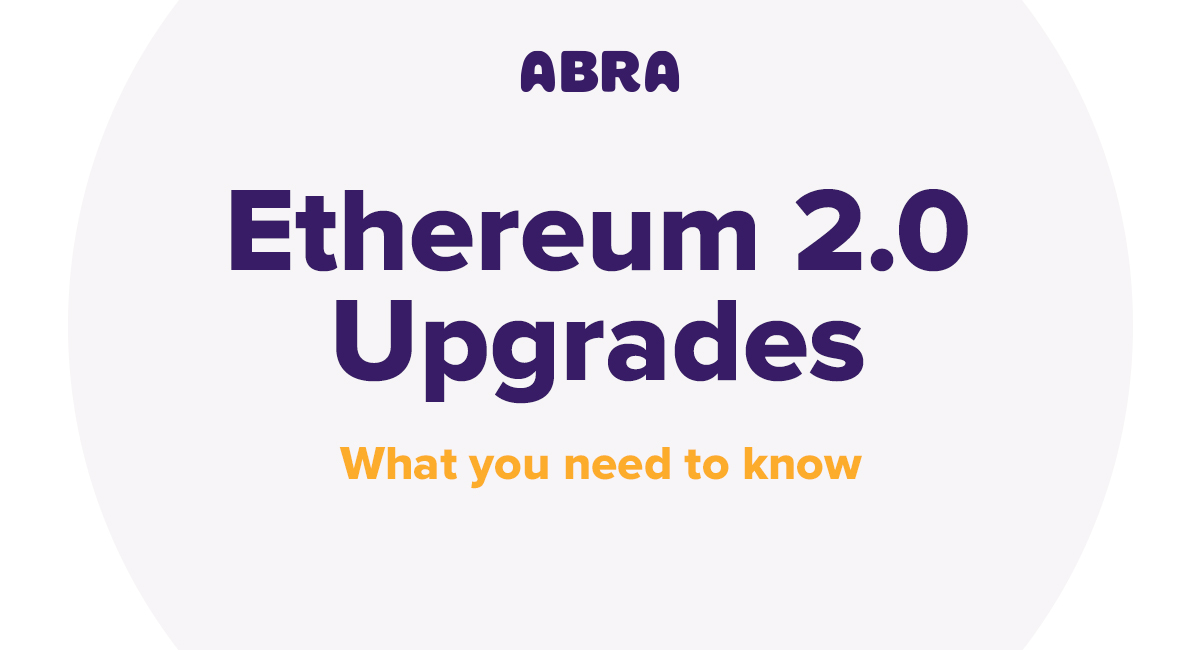As the largest token creation platform and smart contract platform, Ethereum is an integral part of the blockchain industry. At the heart of this innovation is ETH – the coin which powers everything, from simple transactions to complex applications.
With that being said, there is still a lot of work to be done before the Ethereum network is ready for mass adoption. A massive upgrade, known as Ethereum 2.0, is being phased in at the moment.
What is Ethereum?
Ethereum is designed to create more decentralized information networks enabled by a series of distributed nodes and Ethereum wallets. You can hear Abra CEO Bill Barhydt interview Ethereum founder Vitalik Buterin below about the vision for Ethereum.
Why Is Ethereum Upgrading?
Even before Ethereum’s launch in July 2015, one of the biggest known limitations of the network has been its ability to scale up. Handling just around 30 transactions per second (TPS) on average, the Ethereum blockchain has experienced a few growing pains along the way.
All sorts of decentralized applications (dApps) have chosen to launch on Ethereum due to its accessible tools and advanced smart contract logic. Ethereum is a highly popular platform to build on, despite its scalability limitations.
The challenge is that as the network experiences a sudden influx of users, the fees required to pay for transactions on the Ethereum blockchain have increased to high levels. These fees are called gas fees.
For example, in December 2017, the sudden popularity around CryptoKitties was the first time that the network’s scalability challenge was truly exposed. In mid-2020, with the increased usage of Uniswap, gas fees soared to unprecedented levels.
For the average user looking to send ETH to someone or interact with one of the many NFT platforms built on Ethereum, it has often led to issues. For example, there have been numerous occasions where gas fees were more expensive than the funds an end-user wished to send.
To overcome these barriers, a major focus for Ethereum developers over the past few years has been to work towards implementing new scalability upgrades. These technical changes not only impact developers and technical users but also anyone who is using the network.
What Is Ethereum 2.0?
The goal of Ethereum 2.0 has one clear focus: reduce transaction fees to ensure the Ethereum network is suitable for mass adoption. This all comes down to blockchain consensus. This is how validators on the network agree on the validity of transactions.
With Ethereum 2.0, the network is transitioning from Proof-of-Work (PoW) to Proof-of-Stake (PoS) as a means of blockchain consensus. This will enable the network to leap from the current 30 TPS to an expected ceiling of 2,000 to 3,000 TPS. Further enhancements through other scalability solutions are expected to expand this capacity to 100,000 TPS.
What does this mean for the average user? The Ethereum blockchain will become a network that can facilitate payments in seconds rather than minutes, all at a tiny fraction of the current cost.
At the center of this is ETH – which is used to pay gas fees on the network. It’s expected that Ethereum 2.0 will usher in a new wave of adoption with developers and enterprises. The expected result is that more applications will be built on the platform.
The London Hard Fork
Such a drastic improvement doesn’t take place overnight. The switch from PoW to PoS is a process that takes years to complete. A few key milestones are critical to this goal.
One of those is the London Hard Fork – a network upgrade which went live on August 4, 2021. Through hard forks, Ethereum can implement changes known as Ethereum Improvement Proposals (EIPs) to the network. The London Hard Fork is arguably the most important upgrade in the network’s early history.
Five new EIPs will be introduced, with the two most crucial being EIP 1559 and EIP 3554.
- EIP 1559 burns part of the gas fees generated by each transaction on the network. This is controversial among validators because it cuts into the revenue generated for validating transactions.
- EIP 3554 delays the difficulty time bomb from August 2021 to December 2021. The goal of this proposal is to provide more time to make a smooth transition from PoW to PoS.
The London Hard Fork will put Ethereum one step closer towards completing the PoS upgrade, yet there are additional steps ahead (e.g. Shanghai Hard Fork tentatively planned for October 2021).
It’s still too early to know if the London Hard Fork has been successful or not but the early indicators suggest it’s achieving its goals.
Benefits of Moving To PoS
Proof-of-Work validators (known as miners) are currently profitable in mining ETH and remaining in the current system. Some don’t necessarily want to see these upgrades happen while others believe the short-term impact to miners will be worth it based on the long-term benefits to ETH as a whole. The majority of users and the general population are expected to benefit from the move to PoS.
PoW requires a major investment in mining rigs (specialized hardware) that consumes a lot of energy. In 2021, the Bitcoin network’s use of non-renewable energy resources for Proof-of-Work consensus became the subject of media attention.
Ethereum is also responsible for massive energy consumption, but this will change once the network moves to Proof-of-Stake. Estimates from the Ethereum Foundation indicate that the network will become 99.5% more energy efficient as a result.
Proof-of-Stake is also arguably a more egalitarian solution as it costs nothing to stake ETH, whereas mining ETH can even lead to net negative returns in bear markets. The rate of return for staking ETH is expected to be anywhere from 4% to 10% annually, and a few platforms have begun offering an easy route to staking ETH in preparation for the upgrade.
Staking isn’t experimental technology. Numerous coins such as Cardano (ADA), Polkadot (DOT), and Solana (SOL) already use PoS blockchain consensus to secure billions of dollars worth of cryptocurrencies. They offer varying yields, paid in their native coins, to users who stake (lock) funds to secure their respective networks. Soon, ETH will officially join the ranks of these PoS networks.
The Final Frontier – More Scalability And Mass Adoption
As discussed above, Proof-of-Stake will give Ethereum a major boost across the board. Whether it’s lower transaction fees, better incentives for HODLers, or more user-friendly applications, these outcomes will be realized very soon.
Looking further into the future, 2,000 to 3,000 transactions per second just by moving to PoS does sound like major progress … and it is. The exciting part is that this upgrade is only the beginning of Ethereum’s long-term roadmap.
Today there is an abundance of technical solutions that are either being researched or implemented to help Ethereum reach 100,000 TPS. Technologies like sharding, which is already live on the Zilliqa network, will eventually be introduced on Ethereum. Layer 2 solutions like sidechains, plasma, ZK rollups, and optimistic rollups will gain more relevance.
Ethereum is well on its way to cementing its position as a leading blockchain network and rivaling Bitcoin for supremacy.
Join our community and find more people achieving their financial goals through crypto.
Download the Abra app and conquer crypto today!
Download AppAbout Abra
Established in 2014, Abra is on a mission to create a simple and honest platform that enables millions of cryptocurrency holders to maximize the potential of their assets. Abra enables both individuals and businesses to safely and securely buy, trade, and borrow against cryptocurrencies – all in one place. Abra’s vision is an open, global financial system that is easily accessible to everyone.
Why Abra
Based in the United States, Abra is available in over 150 countries and makes it easy to convert between crypto and a wide variety of local fiat currencies. With over 2MM customers, $7B in transactions processed, and $1.5B in assets under management, Abra continues to grow rapidly. Abra is widely loved and trusted – in April 2022, pymnts.com reviewed and rated Abra amongst the top 5 most popular crypto wallets in the market. Abra is backed by top-tier investors such as American Express Ventures and First Round Capital.
How Abra Protects Your Funds
Abra places clients’ financial objectives and security first. Abra practices a culture of risk management across all levels and functions within the organization.
Abra employs a state-of-the-art enterprise risk management framework that comprises a comprehensive set of policies, procedures, and practices detailing all applicable risk-related objectives and constraints for the entirety of the business. Abra has instituted a complete set of requisite systems and controls that continuously enforce these policies, procedures, and practices to manage all operations, including credit and lending. Abra’s independent Risk Committee comprises experienced compliance, risk, securities, and fraud operations professionals with backgrounds in industries ranging from traditional and digital assets banking, payments, remittance, to fintech.
Please visit our FAQ to learn more.


